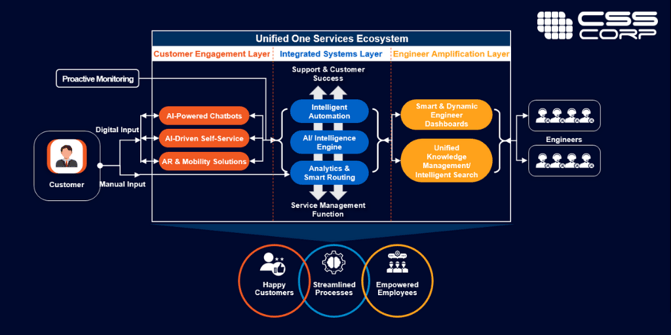The New Normal has hastened enterprise transformation. Amidst high economic uncertainty and low visibility, tech support providers need to shift the way they serve the B2B2C audience. During the onset of the pandemic, customers were sort of okay with average tech support. But the way the crisis has panned out means customers are no longer forbearing. When customers display high levels of anxiety and expectations, how can leaders win in a turf where engagement norms have changed?

The New Landscape of Engagement
Organizations expect the work-from-anywhere trend to continue in the post-pandemic phase. Talent sourcing pros are casting a broader and defined net on the gig economy to source people with specific skill sets in a market.
Digital transformation, which is not a mainstream topic, has seen acceleration. Recent polls from TSIA indicate that 74% of enterprises want to implement digital transformation right away.
Large enterprises who typically talked about custom long-term implementations have gone back to the drawing board to identify innovative solutions that are scalable for future needs. Customers are seeking outcome-based engagements and pricing models based on a blend of digital and traditional services. The focus is not just on the cloud but also on ensuring revenue streams via XaaS-based services in a virtual environment.
The past 5 years witnessed much deliberation around AI, analytics, Automation, and ML. The discussions have now shifted from the table in the board room to the shop floor's implementation plan. For example, AR is becoming pervasive in field-support by improving customers’ troubleshooting experiences and hastening resolutions. Analytics has gone to the next level of providing multi-dimensional views for understanding precise customer intent on a real-time basis. Or accurately pinpointing what the customer's requirement is, thereby accomplishing more with less.
Watch Out! Bumps Ahead
In an environment of high economic uncertainty and low visibility, the new engagement norms present challenges and impacts on tech support and customer service. Let’s take a look:
- The stark shift toward remote work implies diminished visibility into operational performance. Physical proximity plays a significant role in a collaborative environment, which takes a back seat in a WFH setting. And managing the efficiencies of additional service representatives to serve the surge in support requests can prove a costly affair.
- Amidst a high volume of support requests, the remote work environment presents technological disintegration challenges between home-grown applications, phone systems, chat services, and the like. The complexities of a lack of real-time visibility impact execution and business processes.
- Disjointed systems may take a toll on engineers’ experiences as the volume of support tasks surge, become mundane and repetitive. Moreover, managing engineers’ experiences and productivity pose a challenge in the remote work environment.
All of the above issues ultimately hurt the customer who is already under high-stress levels. Delays, tedious processes, inconsistent services, and churn (agents and customers) are terms that support heads don’t want to hear.
“Digital” as an enabler for the tech support ecosystem implies looking through the prism of customer experiences.
Unified One Services Ecosystem
The New Normal mandates a holistic approach that focuses on CX by binding employees, customers, and processes. CSS Corp's integrated digital-led support framework focuses on driving up CX and ensures that operations are fit to address the challenges. The framework streamlines processes, integrates applications, improves engineer experiences, and analyzes volumes of unused data. What springs to life is a powerful combination of automation and contextualization.

Unpacking the Framework
CSS Corp’s 3-layered framework entails 1) customer engagement layer, 2) integrated systems layer, and 3) engineer amplification layer. Here are the top-ticket items in each of these layers:
- The first layer entails intelligent and contextual virtual assistants that interact on a variety of specific use cases. They’re deployable across numerous channels, and they’re not necessarily just “chat.”
- The systems layer plays the central role of integration through smart automation, AI, Analytics, and contact routing engine. This layer takes diverse views of customer intent, sentiment, open tickets, and connects customers to the appropriate engineers.
Customers are frustrated wading through tons of traditional FAQs and “help” content. They want to resolve issues by themselves or by smart virtual assistants.
- The third layer is known as co-telligent support that involves smart engineer dashboards and knowledge management specific to customer intent. Engineers can focus very clearly on resolving the issue in the fastest time possible.
Overall, the framework scales up the agent and customer engagement. The results are happier customers and empowered agents in addition to spikes in CSAT, operational efficiencies, employee productivity, and cost optimization.
The Time is Now
As the economy takes a downturn, tech-support providers need to shift away from approaches that compound problems because of support hiccups, delays, and waiting times. Business leaders who invested in digital agendas and rejigged their business models before the pandemic are in a better position to navigate the crisis unlike their counterparts who are playing catch-up. Investment in a digitally-infused tech support framework can spell a lifeline for near-term survival and long-term growth.
Start digital enablement from the premise of how to amplify agent and customer experience. Speak to a consultant today.
Related Information
- Blog: How KYRA transforms tech support
- Blog: The zen of tech-driven support: 4 perspectives that matter
- White Paper: Technology-driven enterprise support in 2020 & beyond



